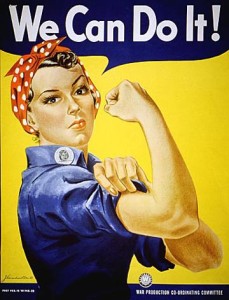Home Front Friday: Real Rosie – Women in the Work Force
Home Front Friday is a regular series that highlights the can do spirit of the Home Front during World War II and illustrates how that spirit is still alive today!
Ahhh, Rosie… the image of female economic independence, a symbol of power and strength, and an icon for feminism. During World War II, propaganda posters of this sort were used to encourage women to enter the industrial workforce. And women did. Between 1941 and 1945, the female percentage of the work force jumped ten percent, making up about 37 percent. With men overseas, women filled vacant positions outside the home, proving they could do the same jobs, often better. In honor of Women’s History Month, let’s take a look at some of the challenges US women overcame striving for equality in the workplace.
Besides historically unequal pay, women were met with many more obstacles. During the Depression, women were criticized for entering the workforce. They were targeted for stealing men’s jobs, though they entered female industries, and criticized for abandoning their children, though they often worked out of dire necessity. Married women were targeted by the government. In 1932, the Federal Economy Act passed, which quite blatantly stated that a married woman could not work in civil service if her husband did as well. Additionally, women were often fired for being married and having children. Up until the late 1930s, labor unions were exclusively male, so women’s rights were left unprotected and exploitable.
FDR’s New Deal helped women in a number of ways. By 1940, 800,000 women workers were unionized, triple the number in 1930. The New Deal legitimized women’s collective bargaining, encouraged women in industry to unionize, and encouraged male unions to include women. Despite this, many of the programs were initially fraught with sexism and racism. For instance, the National Recovery Administration stated that women must be paid less than men.
Until World War II, the plight of the female worker was largely ignored. But with the influx of female workers during wartime, unions began paying attention to women’s labor issues. Women organized themselves, lobbying for national health insurance, free daycare for working mothers, and maternity leave. Many victories were made for women’s rights during World War II. The women workers of the Great Depression and World War II were a part of a long line of women determined to see fair and equal conditions for women in the work force. We honor them by continuing their efforts today, and remembering them this March.
Additionally, Friday, March 13th is Digital Learning Day, which celebrates technology in education and high-quality learning opportunities. To recognize both Digital Learning Day and Women’s History Month, check out some of the Museum’s online assets and digital programming
- Teachers: request a Virtual Field Trip about American women uniting for a cause and aiding their country at home and abroad during WWII
- Check out one of the Museum’s WWII High School Yearbooks from all-girls, St. Ursula Academy in Toledo, Ohio.
Listen to oral histories, view historic short films, and browse photos of female industrial workers in the online component of our special exhibit Manufacturing Victory: The Arsenal of Democracy.
Posted by Laurel Taylor, Education Intern and Lauren Handley, Assistant Director of Education for Public Programs at the World War II Museum
- Posted :
- Post Category :
- Tags :
- Follow responses to this entry through the RSS 2.0 feed. You can skip to the end and leave a response. Pinging is currently not allowed.





Leave a Reply